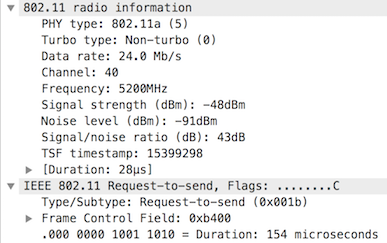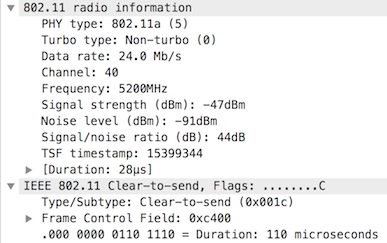Interframe Space Basics
- What is an Interframe Space (IFS)?
- Types of Interframe Spaces
- Examples
- How long is an IFS?
- Where can I find an IFS?
- In a nutshell…
What is an Interframe Space (IFS)?
An interframe space, or IFS for short, is part of a greater process which is used to avoid a collision with other frames. It is basically a period of time that every Wi-Fi device (station) must wait before it transmits an 802.11 frame.
Types of Interframe Spaces
There are 6 types of IFS and each one is used at different times and/or for different purposes. Here is a list to start you off. We will cover each one in a little more detail below.
- DIFS – Distributed Coordination Function (DCF) Interframe Space
- AIFS – Arbitration Interframe Space
- SIFS – Short Interframe Space
- RIFS – Reduced Interframe Space
- EIFS – Extended Interframe Space
- PIFS – Point Coordination Function (PCF) Interframe Space
DIFS
The Distributed Coordination Function (DCF) Interframe Space (DIFS) is used as part of the process to determine who has the right to transmit. In other words, it is used when contending for the RF medium. This is a fixed amount of time.
AIFS
The Arbitration Interframe Space (AIFS) has the same function as the DIFS, except that it is used specifically for Quality-of-Service (QoS) implementations which were introduced as a part of the 802.11e amendment.
Wi-Fi was designed to give statistically equal opportunity to each station to be able to transmit. QoS introduces a way to prioritize communications into categories. Higher priority communications that must compete in the same category have equal opportunity against each other. However, higher priority communications will now have a statistically greater chance over lower priority communications. The length of an AIFS varies based primarily on priority. Compared with a DIFS, an AIFS could be longer or shorter depending on the category of traffic.
Only a DIFS or an AIFS will be used depending on whether the communications use QoS prioritization (for AIFS) or not (for DIFS).
SIFS
Once a station has already been given the right to communicate, the SIFS is used between frames of an individual communication stream. Being that the SIFS is like a building block for other IFS, it is one of the shortest in length. This means that if a station already has an active communication stream, after having waited a DIFS or an AIFS, then waiting only a SIFS means that it will be able to continue that communication stream until it is through because every other station will have to wait at least a DIFS or AIFS which are both longer than a SIFS.
In addition, the SIFS is actually an IFS in its most basic form in that it is a building block which makes up most of the other IFS.
RIFS
The Reduced Interframe Space (RIFS) has a similar function to the SIFS in that it is used after a station has already been given the right to communicate and thus will beat out any other station that must wait a DIFS or AIFS. However, the RIFS is used under very specific circumstances: they are only used following data frames of a Contention-Free Burst (CFB) by 802.11n stations using Multiple Input, Multiple Output (MIMO). What this means is that if an 802.11n station using MIMO has multiple data frames to send and is granted a CFB, it only needs to wait a RIFS before sending another. The RIFS is the shortest of all IFS.
EIFS
The Extended Interframe Space (EIFS) is used when a station receives a frame which fails the Frame Check Sequence (FCS), in which case it waits an EIFS to give the sending station an opportunity the retransmit. The EIFS is the longest of all IFS and so is called “Extended”. I also like to think of the “E” representing that an error may have occurred which helps me to relate it back to a failed FCS.
PIFS
The Point Coordination Function (PCF) Interframe Space (PIFS) was for use specifically in PCF implementations. According to the 802.11-2016 standard, “The PCF mechanism is obsolete.” At this time, it is not all that useful to understand so will not be covered here.
Examples
Example 1: The communication stream will begin with a DIFS for non-QoS or an AIFS for QoS. Between the data and ACK is a SIFS.

Example 2: For an 802.11n MIMO device sending a series of data frames in a CFB, frames originating from the same station are separated by a RIFS.

How long is an IFS?
The length of an IFS varies based on its type and PHY technology.
As discussed above, the SIFS is one of the basic building blocks of most IFS. For communications in the 2.4GHz frequency band, the SIFS is 10 µs. For the 5GHz band, the SIFS is 16 µs. Other IFS include a SIFS as part of their overall length.
Another building block for an IFS is a Slot Time which is 20 µs for DSSS stations as well as ERP stations using a long preamble, or 9 µs for everything else (ERP with short preamble, OFDM, HT, VHT).
The last building block is the time it takes for a station to transmit an ACK (AckTxTime). This is estimated to be 304 µs for a 1Mbps transmission in the 2.4GHz frequency band and 44 µs for a 6Mbps transmission in the 5GHz frequency band.
We now have what we need to figure out how long some of the other IFS are:
- DIFS = SIFS + (2 x Slot Time)
- EIFS = SIFS + AckTxTime + DIFS
- PIFS = SIFS + Slot Time
The RIFS is fixed at 2 µs.
The AIFS varies based on traffic priority and is beyond the scope of this article.
Here is how IFS compare between different PHY:

Here is a visual representation of how the different IFS compare in length for HT in the 5GHz frequency band:
Where can I find an IFS?
You will not find a line in your protocol analyzer (e.g. Wireshark) for an IFS, but you can indeed find them if you look carefully.
Notice that this RTS frame reports in the MAC frame header under “IEEE 802.11 Request-to-send” that this frame has a duration of 154 microseconds (µs). The duration in this portion signifies how long until the end of the communication stream.

Now in the following CTS frame, we see in the same section a duration of 110µs. We also notice under “802.11 radio information” a duration of 28µs. The duration in this section indicates the duration of this frame itself.

The RTS had a duration value of 154µs and the CTS had a duration value of 110µs.
154µs – 110µs = 44µs
We also saw that the CTS frame itself took 28µs.
44µs – 28µs = 16µs = SIFS for an 802.11a (OFDM) transmission!
Thank you, Phil Morgan of NC-Expert, for the inspiration on this section.
In a nutshell…
- DIFS
- Used when non-QoS stations are contending for the medium
- Fixed length
- AIFS
- Used when QoS stations are contending for the medium
- Variable length based on traffic priority
- SIFS
- Used once access to the medium has already been granted
- Fixed length based on frequency band (10 µs for 2.4GHz and 16 µs for 5GHz)
- Building block for other IFS
- RIFS
- Used once access to the medium has already been granted
- Used only by 802.11n MIMO devices
- Fixed length at 2 µs
- Before data frames of a CFB
- Between frames of a single station
- EIFS
- Used when “Errors” occur to allow extra time for re-transmission
- PIFS
- Used only for PCF which is obsolete
References
- CWAP Certified Wireless Analysis Professional: Official Study Guide by Ben Miller, Peter Mackenzie, David D. Coleman, and David A. Wescott
- Official Courseware for CWAP-403

Still a lot more I need study on the foundation of what’s discussed here. A deep understanding of the material is what I’m after primarily and passing the exam is secondary. If I cant explain it then I don’t have a good grasp of the material. At this point I’m not able to articulate the differences between the different interface spaces.
Thanks very much for your response! I’ve added more detail that will hopefully facilitate your understanding. Best of luck to you on your studies!